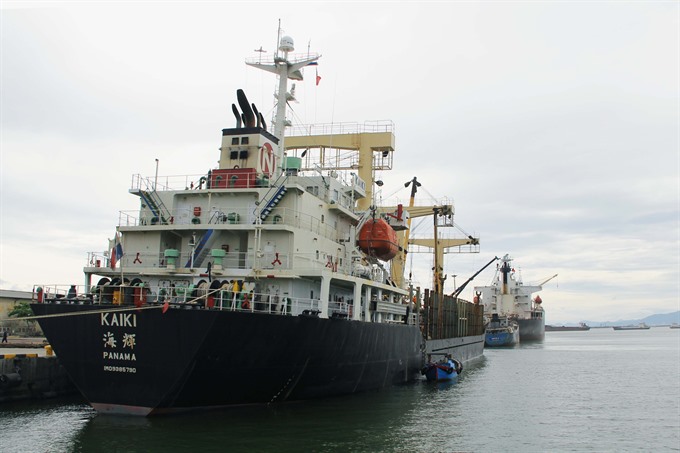 Economy
Economy

Experts have predicted a lacklustre future for a chain of economic zones (EZs) built more than a decade ago in the central region. Instead of working together for common benefits, these EZs are competing against each other.
 |
| Ships docked at Quy Nhơn Port. Every economic zone in the central region relies on a deep sea port. — VNS Photo Phước Bửu |
THỪA THIÊN- HUẾ — Experts have predicted a lacklustre future for a chain of economic zones (EZs) built more than a decade ago in the central region.
Instead of working together for common benefits, these EZs are competing against each other.
The current situation is the result of a condensed distribution of EZs in the region as well as similarities in their functional operations.
The region is a narrow stretch of land running along 1,900km of coastline, including 14 localities ranging from Thanh Hóa to Bình Thuận. Each locality has one EZ, except Ninh Thuận and Bình Thuận.
In 2003, Quảng Nam became the first province to get an EZ in Chu Lai. In 2005, Quảng Ngãi and Bình Định got the Dung Quất and Nhơn Hội EZs, respectively. In 2006, the region got the licence for four more EZs, including Chân Mây-Lăng Cô in Thừa Thiên-Huế, Nghi Sơn in Thanh Hóa, Vũng Áng in Hà Tĩnh and Bắc Vân Phong in Khánh Hòa.
In 2007, Nghệ An got the South East EZ and in 2008, Quảng Bình and Phú Yên got the Hòn La and South Phú Yên EZs, respectively. Đà Nẵng City built a high-tech park in 2010 and had planned for an EZ last year.
Quảng Trị is the latest locality in the region to get the licence for an EZ – the South East Quảng Trị EZ – in 2015. Each of the 12 localities have similar advantages of deep sea ports, of which the prominent ports are Chân Mây, Dung Quất, Đà Nẵng Port and Quy Nhơn Port.
Five among the 12 EZs, including Chân Mây-Lăng Cô, Đà Nẵng Hi-tech Park, Chu Lai, Dung Quất and Nhơn Hội, were grouped to form the Central Key Economic Region by a Government decision in 2008.
According to Dương Đình Giám, former director of the Việt Nam Industrial Policy and Strategy Institute, the EZs offered similar advantages to investors as well as functioned in similar sectors.
“The rate of occupancy of EZs, even in the Central Key Economic Region, is critically low. Some are still waiting for an investor after years of formation,” Giám said.
According to him, the common sectors that EZs had called for investment into include textiles, wood processing, mechanics and beverages.
Trần Đình Thiên, former director of the Việt Nam Economics Institute, said investors were confused to choose one among the “sibling” EZs in the region. “They have similar potential and share the same shortcoming of less-developed industrial infrastructure as well,” he said.
“Every province wants the best for its locality, which is why they do not mind the competition among the EZs. But they are ignoring the fact that competition will drag the region (economy) down,” he added.
Huỳnh Thế Du, head of Fulbright University Việt Nam’s economic training programme, said the economy of the region had almost nothing except brewery factories, Trường Hải Auto and Dung Quất Oil Refinery Plant.
“Đà Nẵng is the prominent locality in the region’s economy, but it comes behind the country’s leading economic cities,” Du said, adding that the central city is the top consumer of the national budget but has low gross domestic product (GDP) contribution. Du said the percentage of labour increase in Đà Nẵng was also low.
At a recent workshop in Thừa Thiên-Huế, experts said cooperation among EZs in the region was impossible as every locality was focused on its own growth.
Du said the only clear path for economic growth in the region was to gather the EZs as one and invest in good infrastructure for all the localities. “Deep sea ports in the region, for instance, can be gathered under one joint stock company, with each having a different function,” he said.
Experts also encouraged the localities to change their mindset in seeking investors by giving up policies on preferential tax and land lease.
“Each EZ should be good enough to attract large, qualified investors by specialising in one or two sectors where it feels the most confident,” said Thiên. He added that Chân Mây-Lăng Cô in Thừa Thiên-Huế, for instance, should focus on medical equipment and manufacture of medicines as well as wellness tourism since medical service and tourism were the key sectors in the local economy.
He emphasised that the focus would make each EZ special for investors and reduce competition among the “sibling” EZs.
Experts also called for a separate governing body for EZs, working independently from the localities’ people’s committees, with an aim of infusing life into a dull economy. — VNS